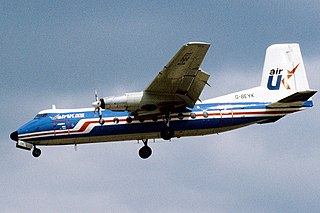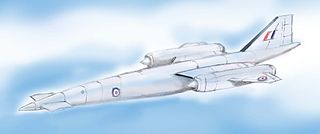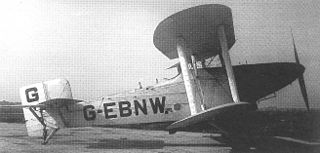Related Research Articles

The Avro Blue Steel was a British air-launched, rocket-propelled nuclear armed standoff missile, built to arm the V bomber force. It allowed the bomber to launch the missile against its target while still outside the range of surface-to-air missiles (SAMs). The missile proceeded to the target at speeds up to Mach 3, and would trigger within 100 m of the pre-defined target point.

The Avro Canada CF-105 Arrow, often known simply as the Avro Arrow, was a delta-winged interceptor aircraft designed and built by Avro Canada. The CF-105 held the promise of Mach 2 speeds at altitudes exceeding 50,000 feet (15,000 m) and was intended to serve as the Royal Canadian Air Force's (RCAF) primary interceptor into the 1960s and beyond.

Handley Page Limited was a British aerospace manufacturer. Founded by Frederick Handley Page in 1909, it was the United Kingdom's first publicly traded aircraft manufacturing company. It went into voluntary liquidation and ceased to exist in 1970. The company, based at Radlett Aerodrome in Hertfordshire, was noted for its pioneering role in aviation history and for producing heavy bombers and large airliners.

The Bristol Aeroplane Company Type 223 was an early design for a supersonic transport. In the late 1950s and early 1960s the company studied a number of models as part of a large British inter-company effort funded by the government. These models eventually culminated in the Type 223, a transatlantic transport for about 100 passengers at a speed around Mach 2. At about the same time Sud Aviation in France was developing the similar Super-Caravelle design, and in November 1962 the efforts were merged to create the Concorde project.

The Avro 679 Manchester was a British twin-engine medium bomber developed and manufactured by the Avro aircraft company in the United Kingdom. While not being built in great numbers, it was the forerunner of the famed and vastly more successful four-engined Avro Lancaster, which would become one of the most capable strategic bombers of the Second World War.

The Handley Page Victor is a British jet-powered strategic bomber, developed and produced by Handley Page, which served during the Cold War. It was the third and final V bomber to be operated by the Royal Air Force (RAF), the other two being the Avro Vulcan and the Vickers Valiant. The Victor had been developed as part of the United Kingdom's airborne nuclear deterrent. In 1968, it was retired from the nuclear mission following the discovery of fatigue cracks, which had been exacerbated by the RAF's adoption of a low-altitude flight profile to avoid interception.

The Avro Type 694 Lincoln is a British four-engined heavy bomber, which first flew on 9 June 1944. Developed from the Avro Lancaster, the first Lincoln variants were initially known as the Lancaster IV and V; these were renamed Lincoln I and II. It was the last piston-engined bomber operated by the Royal Air Force (RAF).

The Handley Page HP.52 Hampden was a British twin-engine medium bomber of the Royal Air Force (RAF). It was part of the trio of large twin-engine bombers procured for the RAF, joining the Armstrong Whitworth Whitley and Vickers Wellington. The newest of the three medium bombers, the Hampden was often referred to by aircrews as the "Flying Suitcase" because of its cramped crew conditions. The Hampden was powered by Bristol Pegasus radial engines but a variant known as the Handley Page Hereford had in-line Napier Daggers.

The Handley Page Halifax is a British Royal Air Force (RAF) four-engined heavy bomber of the Second World War. It was developed by Handley Page to the same specification as the contemporary twin-engine Avro Manchester.

The Handley Page HP.67 Hastings was a British troop-carrier and freight transport aircraft designed and manufactured by aviation company Handley Page for the Royal Air Force (RAF). Upon its introduction to service during September 1948, the Hastings was the largest transport plane ever designed for the service.

The Handley Page HP.81 Hermes was a British civilian airliner built by Handley Page in the 1940s and 1950s. Closely related to Handley Page's Hastings military transport, the Hermes was a low-wing monoplane powered by four piston engines. Twenty-nine were built, serving briefly with BOAC in the early 1950s and later with several charter airlines.
The Handley Page HP.88 was a British research aircraft, built in the early 1950s for Handley Page to test the aerodynamics of the Victor crescent wing design, and was intended to be a scaled-down version of that aircraft.

The Sukhoi T-4, or "Aircraft 100", or "Project 100", or "Sotka" was a Soviet high-speed reconnaissance, anti-ship and strategic bomber aircraft that did not proceed beyond the prototype stage. It is sometimes called the Su-100.

The Handley Page Dart Herald is a 1950s British turboprop passenger aircraft.

The Avro 730 was a planned Mach 3 reconnaissance aircraft and strategic bomber that was being developed by Avro Aircraft for the Royal Air Force (RAF). It had been originally envisioned as a very high-speed aircraft to perform aerial reconnaissance missions, conforming with the requirements of Air Ministry Specification OR.330. Avro subsequently decided to modify the design of the proposed 730 in order to accommodate its arming with nuclear weapons; this change therefore meant that the type would be able to perform the nuclear weapons delivery mission as well, which had been called for under Air Ministry Specification RB.156T which sought a high speed reconnaissance-bomber aircraft.

The Avro 571 Buffalo was a prototype British carrier-based torpedo bomber biplane, designed and built by Avro in the 1920s. It was not selected for service, the Blackburn Ripon being ordered instead.

The Handley Page H.P.24 Hyderabad was a British twin-engine biplane heavy bomber built by Handley Page which served with the Royal Air Force between 1925 and 1933. It was the last wooden heavy bomber to serve with the RAF.

The Avro Canada CF-103 was a proposed Canadian interceptor, designed by Avro Canada in the early 1950s as a development, and possible replacement of the company's CF-100 Canuck, that was entering service at the time with the Royal Canadian Air Force (RCAF). Although intended to be capable of flying at transonic speeds, the CF-103 only offered a moderate increase in performance and capability over the CF-100; subsequently, the aircraft never progressed beyond the mock-up stage.

The Avro Atlantic was a proposed civilian airliner version of the British Avro Vulcan strategic bomber. It was a response to a 1952 UK Ministry of Supply requirement for a new aircraft suitable for both military and civilian long-range roles. Civilian models of the Vickers Valiant and Handley Page Victor V-bombers were also planned for the same contract. The Vickers V-1000 won the contest over the Atlantic, but ultimately none of these designs would be built.
The ARV Griffin is a Canadian homebuilt aircraft that was designed by Dave Marsden of the University of Alberta and produced by Canada Air RV and later by AC Millennium Corp, both of Edmonton. When it was available the aircraft was supplied as a kit for amateur construction.
References
- ↑ "Handley Page H.P.100". Handleypage.com. Archived from the original on 6 October 2003. Retrieved 25 August 2011.
- ↑ "Handley Page H.P.100", Military Aircraft Database, 10 December 2004, archived from the original on 10 December 2004
- ↑ "or3302". Skomer.u-net.com. Archived from the original on 26 September 2011. Retrieved 25 August 2011.
| This article on an aircraft of the 1950s is a stub. You can help Wikipedia by expanding it. |
| This United Kingdom military article is a stub. You can help Wikipedia by expanding it. |